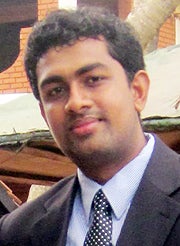
Truong Nguyen
Graduate Assistant, Department of Mathematics
Advisor: Alexander M Alekseenko
Project Description Summary: Gas flows in hypersonic air breathing engines and rocket thrusters and flows of particles into vacuum contain regions where the distribution of particle velocities deviates significantly from the Maxwellian distribution. The gas in these regions is said to be in the non-continuum state and its evolution is best described using kinetic equations. The most physically accurate model of non-continuum gas is given by the Boltzmann kinetic equation. However, because of the very high computational costs associated with the evaluation of the collision integral, solution of the Boltzmann equation is used sparingly. Simpler approximate models are often desired in simulations of non-continuum flows in multidimensional applications. However, validating simpler models may be not easy when experimental data is not available. The goal of the proposed research is to develop novel capabilities for high-fidelity simulation of non-continuum flows with guaranteed accuracy. In particular, we apply the Singular Value Decomposition (SVD) to the Discrete Galerkin formulation of [1] and study the structures of the eigenvalues and eigen functions of the collision kernel. Furthermore, to increase efficiency, we approximate the distribution function by the linear combination of the Maxwellian distributions by using Stochastic Maximum Log Likelihood Optimization techniques. Altogether, we create a convolution form between the Maxwellian distribution function and the eigen function. Using the pre-computed convolutions, we wish to reduce the complexity of the computation of the Boltzmann collision integral to O(MN3), where M is the number of eigen-pairs used. M ~ O(N3) up to some fractions.
Graduate Students 2014-2015
Nguyen, Truong
Nissanka, Uchitha
 Uchitha Nissanka
Uchitha Nissanka
Graduate Assistant, Department of Geological Sciences
Advisor: Dayanthie S Weeraratne
Project Description Summary: Recent global and regional studies of seismic tomography in both oceans and continents show linear bands of low velocity anomalies that are aligned with absolute plate motion and coincident with intraplate volcanic chains. To explain the seismic and gravity anomalies observed beneath the Pacific Ocean small scale convection is frequently cited but this model does explain the wide range of wavelengths that are reported. We propose a new hypothesis suggesting that viscous fingering instabilities can form when hot and wet mantle plumes discharge into the upper mantle and displace higher viscosity depleted asthenosphere. Fingers travel laterally through the asthenospheric channel below moving plates and are correlated with melting and intraplate volcanic chains observed on the seafloor. The development of viscous fingering instabilities are investigated in laboratory fluid experiments using high viscosity miscible fluids in a Hele-Shaw cell scaled to the Earth using appropriate non-dimensional parameters. Plate motion will be simulated using a sheet of mylar moving over radial fingers. This new model for viscous fingering may link off-axis mantle plumes to spreading centers where they contribute to melting, surface volcanism and the growth and formation of new lithosphere.
Quintero, David
 David Quintero
David Quintero
Graduate Assistant, Department of Biology
Advisor: David Bermudes
Project Description Summary: Exploring the use of live bacteria for the treatment of cancer. In order for bacteria to kill cancer cells, they must produce and export proteins that have an anticancer effect without the proteins being broken down by the proteolytic environment of the tumor. To protect anti-cancer proteins he is investigating the use of a trypsin inhibitor derived from sunflower plants genetically fused to a bacterial secreted protein to generate a chimeric protease inhibitor secreted by tumor-targeted Salmonella. Co-expression of this inhibitor with a tumor-specific cytotoxin may lead to a synergistic anti-tumor effect.
Rivera, Yeimy
 Yeimy Rivera
Yeimy Rivera
Graduate Assistant, Department of Physics and Astronomy
Advisor: Ana Cristina Cadavid
Project Description Summary: My research pertains to the study of the mechanisms to heat the solar corona. It uses satellite observations of solar Active Regions from the Solar Dynamics Observatory (SDO) obtained by the Atmospheric Imaging Assembly (AIA) in six Extreme Ultraviolet (EUV) intensity channels with wavelengths (94, 131, 171, 193, 211, 335) Angstroms (A). To investigate if the nanoflare heating mechanism is taking place we investigate the time lags of intensity time series for localized structures and for the full active region maps. The hot components of the 131A and 94A signals leading the remaining EUV channels in decreasing cooling order (335A, 211A, 193A, 171A) would provide evidence of a strong nanoflare storm. If the process is lead by the 335A signal with the cool components of the 131A and 94A at the end, then the process corresponds to a low intensity nanoflare storm.
Zambri, Brian
 Brian Zambri
Brian Zambri
Graduate Assistant, Department of Mathematics
Advisor: Rabia Djellouli
Project Description Summary: The main objective is to calibrate a brain response model using fMRI measurements. The developed solution method is a regularized iterative method equipped with a denoising procedure. The inverse problem considered attempts to identify the biophsyiological parameters of the Balloon model, as well as the parameters of the control function used in the model.






